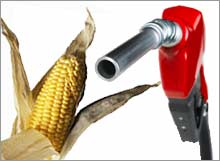NEW YORK (CNNMoney.com) -- It's no secret that the rush to ethanol and other alternative fuels has made corn the rock star of the Farm Belt.
That newfound prominence has big implications for the nation's economy, experts say. Soaring corn prices are pushing up the tab for everything from candy to corn flakes, moribund land values have jumped in many Midwestern farming communities and the crop has become the lynchpin for the budding $40 billion ethanol industry.
 |
| Prices for corn have doubled during the last two years, a trend that's pushing food prices higher. |
With corn farmers now getting $4 a bushel for their crops - double the price just two years ago - corn's become the crop of choice for farmers. And with the government's release Friday of a key report likely to show a jump of 11 percent or more in the amount of acreage farmers plant with corn this year, the 7,000-year-old crop will remain front and center in the eyes of economists and millions of other Americans.
"It really is a bit of uncharted territory," said Christopher Hurt, an economist at Purdue University, referring to the vast increase targeted for corn production. "We've never seen a year where we've needed to shift so many acres into corn because of a dramatically large increase in demand for the commodity."
Corn is the main ingredient in U.S.-made ethanol, the biofuel the Bush administration hopes will start to wean the United States away from oil. President Bush has set to reduce gasoline consumption 20 percent the next 10 years.
Last year some 2.1 billion bushels of corn produced ethanol at 106 plants nationwide. That number is expected to jump to 3.5 billion bushels this year as dozens of new plants come on line or get expanded, according to the Renewable Fuels Association.
As corn output jumps, farmland devoted to other crops will drop. Acreage devoted to cotton, for instance, is expected to show a 14 percent decline from 2006, according to the National Cotton Council. Soybeans, wheat, barley, oats and alfalfa also will be displaced.
The corn phenomenon will be felt in the market in a variety of ways.
The high demand for corn, which accounted for about 10 percent of the $305 billion farm industry last year, will push food bills up faster than the overall rate of inflation, economists say. That's because corn and corn-based sweeteners are used in so many foods and soft drinks.
Meanwhile, farmers benefiting from higher prices for corn - and higher land values - could also get higher prices for other crops that corn has displaced.
"I think the probability now is very large for 2007 and 2008 that price increases in the food and beverage sectors are going to outpace the general inflation rate," said Hurt, who predicted food prices will rise 5 to 7 percent in each of those years compared to the norm of about 3 percent.
"Energy has been the bigger component of inflation these past two years, while food helped to moderate that. Now you have a scenario where food and beverage are going to be leading inflation."
Most economists are predicting the U.S. will say farmers are planting some 88 million acres with corn this year, up from 78 million in 2006. The Department of Agriculture is due to release its annual crop survey on Friday. March is a pivotal month for the survey because it's when farmers announce their planting intentions. Corn prices are expected to stabilize around $4 a bushel, up 20 percent from last year and a 100 percent spike over 2005.
But into each crop's life a little rain must fall, and too much precipitation could spoil corn's reign as king of the crops.
A wet spring would delay corn planting. A shorter growing season would cut output and could cause nasty swings in prices. A spike in prices would hurt the ethanol industry, which is depending on stable costs.
A study at Iowa State University several months ago pegged at $4.05 a bushel the maximum price that ethanol plants could pay and remain profitable. Any rise beyond that would greatly reduce the incentives to build new plants and make ethanol, sending the corn industry and the U.S. energy policy into a dual tailspin.
Mark Schultz, an analyst at Northstar Commodity Investment Co. in Minneapolis, believes that excessive rainfall is the only thing that can slow down the corn market. "The demand continues to get stronger for ethanol and that's going to continue on. We don't see anything slowing that down at the present time," Schultz said.
But he's also watching other effects of corn's growth, and notes that the increase in corn prices has meant less feed for livestock. Cattle weights have dropped 10 to 20 pounds during the past year, he said. Experts disagree on whether the falling cattle weights will lead to higher beef prices.
William Plummer, a commodities trading adviser at Wextrust Capital based in Chicago, said he is bullish long-term on corn prices.
"I don't think we can ramp up production of agricultural products fast enough to compensate for the growth of ethanol facilities in the U.S.," he said.
"This price level that we're looking at right now is going to be on the low side or certainly the medium-low side of where we're going to be. We're not going to see corn under three bucks unless there's some sort of catastrophe."
Betting on the farm
Corn prices making Coke gulp 